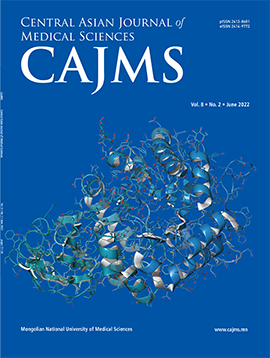Vitamin D Status in Mongolian Pregnant Women and Birth Outcomes
DOI:
https://doi.org/10.24079/cajms.2021.12.008Keywords:
25(OH)D, Umbilical Cord, Apgar Score, Newborn Measurements, RicketsAbstract
Objectives:Vitamin D deficiency and insufficiency in pregnancy can lead to gestational diabetes, preeclampsia, and eclampsia, as well as newborns having Vitamin D deficiency. This study was performed to determine the amount of maternal, neonatal Vitamin D, and consequences of Vitamin D deficiency on birth outcomes. Methods: Hospital-based prospective research was conducted on 528 participants which included 264 mothers and 264 neonates. Pre-delivery maternal venous blood and neonatal cord blood samples were collected and total 25(OH)D concentration was measured. After checking the normality of data distribution, methods of result presentation and statistical analyses were applied. Results: The average level of 25(OH) D in the mother’s blood was 16.53 ± 6.5 ng/ml. The total Vitamin D deficiency in mothers was 191 (72.3%), insufficiency was 63 (23.9%), and 10 (3.8%) registered levels of sufficiency. Maternal serum 25(OH)D was significantly correlated with cord blood 25(OH)D (r = 0.87, p < 0.01). Conclusion: A high proportion of Vitamin D deficiency was found in both mothers and newborns in our study. There is a strong correlation between the amount of Vitamin D in the mother’s blood and in the umbilical cord blood of the newborn. Complications of pregnancy are not associated with Vitamin D status in mother’s blood.
Downloads
237
Downloads
Published
How to Cite
Issue
Section
License
Copyright (c) 2021 Mongolian National University of Medical Sciences

This work is licensed under a Creative Commons Attribution-NonCommercial 4.0 International License.




